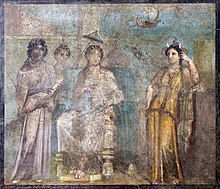Africa (goddess)



Goddess Africa, also known as Dea Africa, was the personification of Africa by the Romans in the early centuries of the common era.[1][2] She was one of the fertility and abundance deities to some. Her iconography typically included an elephant-mask head dress, a cornucopia, a military standard, and a lion.[3]
To the Romans "Africa" was only Tunisia, which they had conquered, and the goddess/personification was not given African characteristics; she was possibly thought of as Berber, but this cannot be judged in the great majority of representations. This changed after she was revived in the Renaissance, by now clearly only the personification of Africa with no divine pretensions.[citation needed]
Roman use
She is portrayed on some coins, carved stones, and mosaics in Roman Africa. A mosaic representing Roman Africa is found in the El Djem museum of Tunisia.[1][4][5] A sanctuary found in Timgad (Thamugadi in Berber) features goddess Africa's iconography.[6]
She was one of a number of "province personifications" such as
The elephant headdress is seen first on coins depicting
Goddess
To the Romans the distinction between goddesses who received worship and personification figures understood to be literary and iconographic conveniences was very elastic, and Africa seems to have been on the boundary between the two. She was certainly not a major deity, but may have received worship at times.
Maritz, however, has questioned whether personified Africa was ever a "Dea" or goddess to Romans, or anywhere else. The iconographic images of "Dea Africa" with elephant scalp head dress was just a Roman icon for Africa, states Maritz. This is likely because neither Pliny nor any writer thereafter ever described her as "Dea", nor is there an epigraphical inscription stating "Dea Africa". In contrast, other Roman goddesses carry the prefix "Dea" in texts and inscriptions. Romans already had their own goddesses of fertility and abundance, states Maritz, and there was no need for a competing goddess with the same role.[12]
Renaissance revival
In the Renaissance Africa was revived, along with other personifications, and was, by the 17th century, usually given a dark complexion, curly hair and a broad nose, in addition to her Roman attributes.
See also
- Bona Dea
- Ceres (mythology)
- Leticia
- Libera (mythology)
- Ops
- Terra (mythology)
- Vestal Virgin
References
- ^ a b c Gifty Ako-Adounvo (1999), Studies in the Iconography of Blacks in Roman Art, Ph.D. Thesis awarded by McMaster University, Thesis Advisor: Katherine Dunbabin, page 82
- ^ Christine Hamdoune (2008), La dea Africa et le culte impérial[permanent dead link], Études d'antiquités africaines, Volume 1, Numéro 1, pages 151-161
- ISBN 978-0-8078-4942-2.
- ISSN 1047-7594.
- ISBN 90-04-06331-5.
- ISBN 978-88-430-3990-6.
- ^ ISBN 978-0-19-921597-3.
- ^ a b Lorber, Catherine (2018). Coins of the Ptolemaic Empire. New York: American Numismatic Society. p. 46-59.
- ISBN 9780191894343.
- ^ J. A. Maritz (2006), "Dea Africa: Examining the Evidence", Scholia: Studies in Classical Antiquity, Volume 15, page 102
- JSTOR 283685.
- ^ J. A. Maritz (2006), "Dea Africa: Examining the Evidence", Scholia: Studies in Classical Antiquity, Volume 15, pages 102-121
- ISBN 9789004310438.
Further reading
- Paul Corbier, Marc Griesheimer, L’Afrique romaine 146 av. J.-C.- 439 ap. J.-C. (Ellipses, Paris, 2005)
